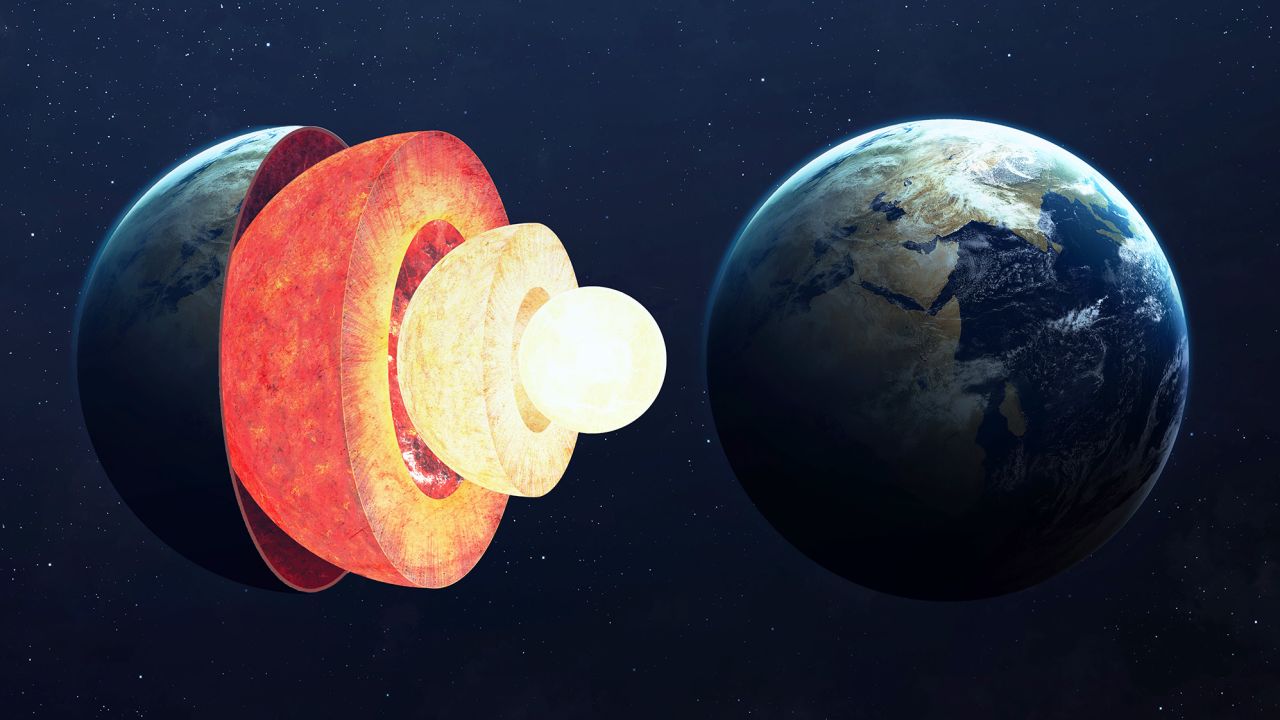(CNN) – A new study finds that the rotation of the Earth’s inner core may have stopped and possibly reversed.
The Earth is made up of the crust, mantle, and inner and outer cores. The solid inner core lies about 5,000 kilometers below the Earth’s crust and is separated from the semi-solid mantle by the liquid outer core, which allows the inner core to rotate at a speed other than the rotation speed of the Earth itself.
Chinese scientists suggest that the rotation of the Earth’s core may have stopped. Credit: Adobe Stock
With a radius of just over 3,500 km, the Earth’s core is on about the size of Mars. It consists mostly of iron and nickel, and contains about a third of Earth’s mass.
in Research Published Monday in the academic journal Natural Earth SciencesYi Yang, an associate research scientist at Peking University, and Xiaodong Song, a professor at Peking University, studied seismic waves from earthquakes that traversed Earth’s inner core following similar paths since the 1960s to infer how fast the inner core is spinning?
The result was unexpected. Since 2009, seismic records, which previously changed over time, have shown little variation. They said that this indicates that the rotation of the inner core has stopped.
“We make surprising observations that the inner core has nearly stopped spinning in the past decade and may even be going through a reversal,” they wrote in the study.
“When you look at the decade between 1980 and 1990, you see a clear change, but when you look at the period from 2010 to 2020, you don’t see much change,” Song added.
The rotation of the inner core is driven by the magnetic field generated in the outer core and balanced by the gravitational effects of the mantle. Knowing how the inner core rotates could shed light on how these layers and other processes interact deep within the Earth.
However, the speed and variability of this rotation is up for debate, says Hrvoje Tkalczyk, a geophysicist at the Australian National University, who was not involved in the study.
“The inner core never completely stops,” he said. He said the study’s findings “mean that the inner core is now more in sync with the rest of the planet than it was a decade ago, when it was spinning a little faster.”
“Nothing catastrophic happens,” he added.
Song and Yang argue that, according to their calculations, a small imbalance in the electromagnetic and gravitational forces could slow and even reverse the rotation of the inner core. They believe this is part of a seven-decade cycle, and that the turning point prior to the one they detected in their data for 2009/10 occurred in the early 1970s.
“The study’s data analysis is robust,” said Tkalcik, author of Earth’s Inner Core: Detection of Observed Earthquakes. However, the study’s conclusions “must be taken with caution” as “more data and innovative methods are needed to shed light on this exciting problem.”
Song and Yang agreed on the need for further investigation.
Geocentric study
Tkalcic, who devotes an entire chapter of his book to the rotation of the inner core, suggested that the inner core cycle lasts from 20 to 30 years, rather than the seventy suggested in the last study. He explained why these differences occur and why it is difficult to understand what is happening in the interior of the planet.
“The bodies of our studies are buried thousands of kilometers under our feet,” he said.
“We use geophysical inference methods to infer internal characteristics of the Earth, and care must be taken so that interdisciplinary results confirm our hypotheses and conceptual frameworks,” he explained.
“Seismologists can be thought of as doctors who study the internal organs of patients’ bodies using limited or incomplete equipment. Therefore, despite progress, our internal picture of the Earth remains hazy, and we are still in the discovery stage.

“Proud web fanatic. Subtly charming twitter geek. Reader. Internet trailblazer. Music buff.”


:quality(85)/cloudfront-us-east-1.images.arcpublishing.com/infobae/7TXNTX4Z6ZADNGBBYTUT45QETM.jpg)
:quality(85)/cloudfront-us-east-1.images.arcpublishing.com/infobae/TR43PX4FQRCGJOYTK6DVVHHXGE.jpg)


More Stories
NASA finds rock on Mars that may contain ancient microscopic life
Astronauts stranded in space due to Boeing spacecraft malfunction won’t be able to return home for weeks
Download YoWhatsApp Plus 2024 Latest Updated APK for Android | WhatsApp Plus APK